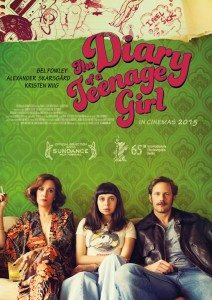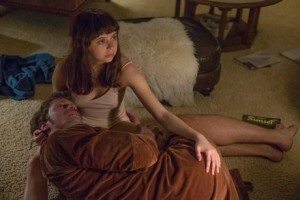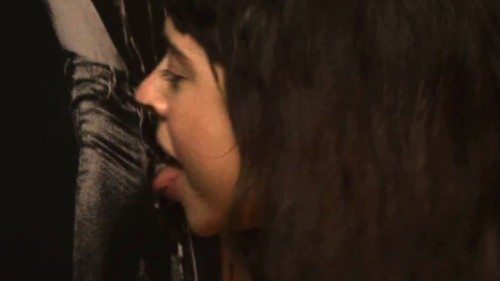 Sleeping with your mom’s boyfriend? Check. Blowing boys for cash? Check. Doing coke with mom and her friends? Check. Licking Iggy Pop’s crotch on the poster on your wall? Che—Wait, what?
Sleeping with your mom’s boyfriend? Check. Blowing boys for cash? Check. Doing coke with mom and her friends? Check. Licking Iggy Pop’s crotch on the poster on your wall? Che—Wait, what?
The Diary of A Teenage Girl tells it like is, and what is it like? Horny, curious and fearless. Without moralizing, without embarassment, without judgment, it tells the tale of 15-year-old Minnie Goetze’s sexual and, to a lesser degree, artistic awakening in 1976 San Francisco, and does it with a kind of honesty rarely seen in any coming-of-age movies, let alone one about a girl, of which there are precious few.
Based on the graphic novel by Phoebe Gloeckner, The Diary of A Teenage Girl is written/directed by Marielle Heller, her first film. It’s one hell of a debut. She’d earlier adapted Gloeckner’s book for the stage, and played the lead herself, to much acclaim, hence Gloeckner granting her the film rights. I can’t imagine anyone doing a better job with the material.
How do you tell the story of a 15-year-old girl sleeping with a 35-year-old man and not make it salacious, or a warning to the youth, or merely icky? It’s no simple trick. I’m predicting many think-pieces on this movie once it opens. People are going to be talking about it. Some will be angry. Many will be jubilant.
Bel Powley plays Minnie, and does so fearlessly. She’s innocent, seductive, wise, foolish, scared, and brave, usually at the same time. She’s a teenager, in other words. Full of her own power with no idea how to use it. Kristin Wiig plays her mom, Charlotte, and Alexander Skarsgård plays the boyfriend, Monroe. The thing about Monroe is that he’s just some regular, bell-bottoms wearing, go-with-the-flow guy. He’s not evil. He doesn’t trick Minnie, or even seduce her. She seduces him. Not that he puts up so much as a hint of a fight.
The movie opens with Minnie floating dreamily through Golden Gate Park (over by Hippie Hill, for you locals). “I just had sex,” she says, and proceeds to tell us all about it.
Is it abuse, this older man having sex with her, despite her initiating it? Some would argue thus. Others wouldn’t. Wisely, Heller makes no judgments. The movie consists of Minnie’s experiences, and shows us how she feels about them. Does she learn from them? In some cases, right away. Such as when Minnie and her best friend, Kimmie (Madeleine Waters), making eyes at two boys in a bar, decide it would be fun to act like prostitutes, and offer to blow the boys in the bathroom for cash. Which they do. Cut to the girls on Minnie’s bed the next morning, promising each other never to do that again.
But what about the larger issues, such as seducing one’s mother’s boyfriend? Does Minnie regret her actions? Does she see what she’s done as the betrayal it is? The movie doesn’t have time to wait around and see. It’s about what’s happening to Minnie right now. She doesn’t quite know what she’s doing, just that she wants to be doing it.
Though Minnie’s relationship with Monroe—theirs is not a one night fling, it goes on and on—is the backbone of the movie, otherwise there’s no real story, per se. Only Minnie’s explorations into the world of adults. Yet the movie never feels boring or unfocused. Powley is consistently fascinating to watch. She’s shot to look as plain as can be in some scenes, and in others, made up and lit to look sexy beyond her years. Like a teenager. She has no role models in her life, no one to tell her what’s right and wrong, what’s expected of her. She’s desperate to have sex with Monroe because she figures no one else would ever want her.
The whole movie is presented in an almost sepia-toned color scheme of browns and yellows, for that classic ‘70s look, yet it’s subtle enough not to be obnoxious. Heller stays out of the way as a director. She’s made a stylish movie without calling attention to her style.
The other thread, aside from Minnie’s sexual and emotional awakening, is Minnie as budding artist. She wants to draw like Aline Kominsky of Twisted Sisters comics, so writes her fan letters, and starts drawing her own comics, a number of which come to animated life. Other animations crop up occasionally, flowers and stars and posters on walls, combining with the cinematography to give a slightly dreamy feeling to the movie’s ‘70s setting.
I wonder if this look is a way to add some distance to Minnie’s rather gritty life? It’s such a blunt movie. Powley was 21 when the movie was shot, but she’s playing 15, and she’s naked and having sex often, with a character 20 years her senior (and younger ones too, male and female), and drinking, smoking weed, and snorting coke, in one scene at home during one of her mom’s many bohemian parties. One does not expect to see this kind of thing in American movies.
Yet however blunt are Minnie’s experiences, the movie doesn’t feel weighty. It’s often very funny, and there’s the animation and the color scheme tempering the reality, but I think what’s most important is the absence of moralizing. It feels freeing to see this kind of story without being told what’s right, what’s wrong, what to think, what to feel. We’re experiencing what Minnie is experiencing, and like her, it’s up to us to decide what lessons to take away.
Another unusual aspect of Minnie’s journey is how she’s in control of her every action. No one forces anything on her. Her decisions are certainly questionable—in many cases they’re simply bad—but they’re hers, every one. Only late in the film does she almost allow herself to be drawn into someone else’s fucked up drug/sex thing, and at the last second she runs. She wants experience, and she goes for it.
Minnie isn’t a hero but neither is she a victim. Monroe uses her, but she uses him, too, and in the end she’s the stronger for it. If anyone is messed up by their affair, it’s him. He’s weak of will and character, the opposite of Minnie, and however inappropriate their affair, his emotional attachment to her is real.
The Diary of A Teenage Girl doesn’t exist to send a message to girls. It neither warns them away from Minnie’s actions nor endorses them. It exists to show the swirling passions inside a young girl’s head, and what this specific girl does about them. A rare thing. How many movies about teenage boys wanting sex are out there? Well, all of them, pretty much. Heller sets out to tell the story from the other side. What’s it like being a horny teenage girl in a world where girls wanting sex is labelled wrong and depraved? What are you supposed to do? How are you supposed to act? Minnie doesn’t know. No one’s around to tell her. So she finds out for herself.








I guess I’ll have to see this, then.
And now I have. A strange lovely film. Slightly too slow for my baby-beaten brain, but so different and so honest.
I would love to hear what actual teenagers think of it. Are you reading this and a teenager? If so, please tell me what you think of this film.